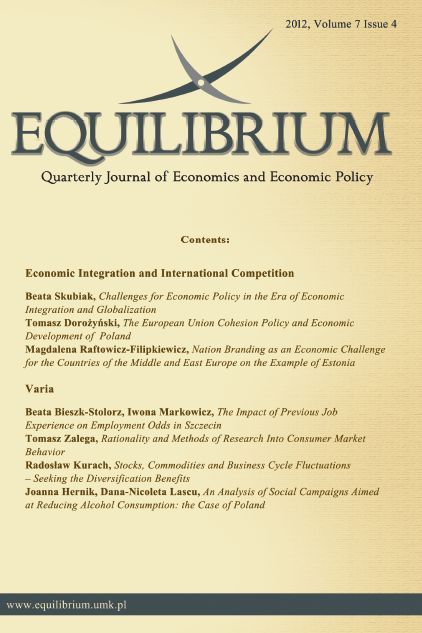The EU cohesion policy and economic development of Poland
DOI:
https://doi.org/10.12775/EQUIL.2012.025Keywords:
EU cohesion policy, economic development, economic regional disparitiesAbstract
In order to remove regional economic disparities, the EU realizes the cohesion policy. The evaluation of the cohesion policy from the point of view of experiences of individual member states and the EU is not explicit. What is especially controversial here, are unsuccessful attempts to reach the main goal, which is social, economic and territorial cohesion. It does not mean the negation of outcomes of numerous researches which confirm a positive influence of the cohesion policy on the economic growth. The subject for a discussion is the right balance between the equality and effectiveness. The key issue is an answer to the question who and how to support. The question is whether the aid should be directed at the areas which guarantee the highest added value? Should it be the priority to give equal opportunity to the poorest and to support them? At present the cohesion policy is trying to combine both those goals. However, with the limited measures and rising social, economic and territorial disparities, those actions are ineffective. The pace of economic growth in Poland in the recent years ? bigger than the average in the EU ? has contributed to the making up for part of a development distance towards the rest of the member states. The cohesion policy had some participation in this process. The evaluation of the influence of the cohesion policy is not easy, though. One has to, however, separate its influence from other factors affecting the social-economic situation of the regions. The main aim of the article is an evaluation of the role of the EU cohesion policy in the stimulation of social-economic development of Poland, in particular its impact on the economy of the regions. The research method is an analysis of the literature of the subject. The bases of the conducted research were: statistical data, program documents, reports, national and EU law, quantitative and qualitative research and secondary sources presented in various studies.
Downloads
References
Domański R. (1995), Zasady geografii społeczno-ekonomicznej, PWN, Warszawa-Poznań.
Domański R. (2003), Nowe ujęcie koncepcji endogennego wzrostu regionów szansą dla regionów peryferyjnych [in:] A. Bołtromiuk (ed.), Regiony peryferyjne w perspektywie polityki strukturalnej Unii Europejskiej, Wydawnictwo Uniwersytetu w Białymstoku, Białystok.
Efekty polityki spójności UE w Polsce (2009), Ministerstwo Rozwoju Regionalnego, Warszawa.
El-Agraa A.M. (2001), The European Union. Economics and Policies, Pearson Education.
Galiński P. (2009), Finansowanie polityki regionalnej w republice Irlandii i w Wielkiej Brytanii, Wydawnictwo Uniwersytetu Gdańskiego, Gdańsk.
Gawlikowska-Hueckel K. (2003), Procesy rozwoju regionalnego w Unii Europejskiej ? Konwergencja czy polaryzacja?, Wydawnictwo Uniwersytetu Gdańskiego, Gdańsk.
Głąbicka K., Grewiński M. (2003), Europejska polityka regionalna, Dom Wydawniczy Elipsa, Warszawa.
Growing Regions - growing Europe (2007), Fourth Report on Economic and Social Cohesion, European Commission, Luxembourg.
Jewtuchowicz A. (2005), Terytorium i współczesne dylematy jego rozwoju, Wydawnictwo Uniwersytetu Łódzkiego, Łódź.
Kundera J. (1996), Liberalizacja obrotów gospodarczych w strefach wolnego handlu, Wydawnictwo Uniwersytetu Wrocławskiego, Wrocław.
Maier G., Tödtling F. (1987), International Division of Labour and Industrial Change in Austrian Regions, [in:] H. Muegge, W. B. Stöhr (ed.), International Economic Restructuring and the Regional Community, Avebury, Aldershot, UK and Brookfield, Vt, USA.
Mikosik S. (1993), Teoria rozwoju gospodarczego Josepha A. Schumpetera, Wydawnictwo Naukowe PWN, Warszawa.
Molle W. (2000), Ekonomika integracji europejskiej, Fundacja Gospodarcza, Gdańsk.
Myrdal G. (1963), Economic Theory and Under-Developed Regions, University Paperbacks, London.
OECD Territorial Reviews: Poland (2008), OECD.
Pelkmans J. (1997), European Integration. Methods and Economic Analysis, Longman.
Pietrzyk I. (2004), Globalizacja, integracja europejska a rozwój regionalny [in:] A. Jewtuchowicz (ed.), Wiedza, innowacyjność, przedsiębiorczość a rozwój regionów, Wydawnictwo Uniwersytetu Łódzkiego, Łódź.
Polityka spójności po 2013 r. Pożądane kierunki reformy (2008), Ministerstwo Rozwoju Regionalnego, Warszawa.
Stackelberg von K., Hahne U. (1998), Teorie rozwoju regionalnego, [in:] S. Golinowska (ed.), Rozwój ekonomiczny regionów. Rynek pracy. Procesy migracyjne ? Polska, Czechy, Niemcy, Raport Instytutu Pracy i Spraw Socjalnych, Warszawa.
Szmyt W. (1999), Teorie rozwoju regionalnego ze szczególnym uwzględnieniem modelu rdzenia i peryferii, Acta Universitatis Wratislaviensis, Ekonomia 6/1999, No 2176.
Wpływ polityki spójności na rozwój społeczno-gospodarczy Polski w latach 2004-2015 w świetle wyników badań ekonometrycznych (2010), Ministerstwo Rozwoju Regionalnego, Warszawa.
Zielińska-Głębocka A. (1996), Handel krajów uprzemysłowionych w świetle teorii handlu międzynarodowego, Wydawnictwo Uniwersytetu Gdańskiego, Gdańsk.






